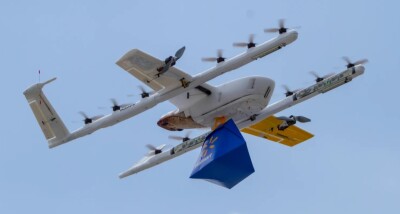For years, we in the US have been hearing the news that drone deliveries are right around the corner. Well, it must be a building with a lot of corners, because we are still waiting. Tests around the country are increasing and certainly going well, but they are still a meager percentage of the overall delivery business.
In the meantime, companies based in other countries around the world are having great success with delivering packages using uncrewed aerial vehicles (UAVs) in both urban and rural areas. Cases like Aerialoop in Ecuador, Speedbird in Brazil and nine other countries, ORKID in Colombia, and Zipline in various countries in Africa have something in common and that is that their target market is not delivering to the end user, but instead solving the weakest link in their particular distribution chain.
In the US, companies such as Walmart and Amazon have advocated for years that the drone delivery business model should be based on taking the package directly from their distribution centers to the end user, simply replacing a 2,000 lbs. truck with a 55 lbs. drone.
Well, it is not working.  First, because most of these flights are performed over heavily populated areas and are, by definition, beyond the visual range of the operator (BVLOS) and therefore conducted under a Federal Aviation Administration (FAA) Certificate of waiver or Authorization (COA) of the current Part 107. No successful business model can be based on operations under exceptions.
First, because most of these flights are performed over heavily populated areas and are, by definition, beyond the visual range of the operator (BVLOS) and therefore conducted under a Federal Aviation Administration (FAA) Certificate of waiver or Authorization (COA) of the current Part 107. No successful business model can be based on operations under exceptions.
Aerialoop in Ecuador has become the largest airline in the country by number of flights precisely because they are operating under conventional civil aviation authority rules and only solving the piece of the distribution link that needs fixing, which, in the case of Ecuador, is the middle mile.
Speedbird, on the other hand, is operating regularly in Brazil, Scotland, Israel, Singapore, and many other countries simply by establishing a delivery model that does not necessarily involves delivering to the final user. Instead, Speedbird has partnered with a number of large traditional delivery companies that bring packages to a vertiport and then deliver to the end user on the other side of the delivery chain. Speedbird’s genius is that they have chosen islands or remote areas separated by large bodies of water as their preferred initial target market. This means that over 90% of the flight is conducted over water and mostly free of strong opposition from the public or the regulator. This approach provides Speedbird’s leadership with thousands of flight hours that will be invaluable when the time comes to attempt direct deliveries.
Zipline has focused on transporting life-saving supplies in rural Africa, operating from self-created and managed vertiports, and delivering by using an ingenious parachute system that allows the aircraft to drop the load, and then simply turn around and return to the base ready for the next flight. Recently, they announced the completion of its millionth flight: A monumental accomplishment in the world of uncrewed aviation.
So, why is everyone in the US so fixated on the end user as the only valid target for drone deliveries? In my opinion, it is a fact that most business models in the US are based on serving the consumer and making a profit by volume of sales, not by the profitability of each transaction.
I shared this opinion with Manoel Coelho, CEO of Speedbird, in an informal conversation over coffee and he shared his view on the matter:
“I believe that the problem lies with investors and their unwillingness to put money in a business model that is not directed at the end user or final consumer of the goods being distributed by drone,” he said. “If you propose a business model that does not involve delivering the package to the door of the end-user, venture capital is afraid of the return of investment (ROI) and the feasibility of a scheme that does not involve the American consumer directly.”
We have all heard that 70% of the US economy is generated by consumer spending, and that translates into $20 trillion dollars, a pretty attractive total addressable market (TAM), but that approach means operating under waivers and only serving people with backyards, not living in apartments.
In the meantime, large companies keep announcing that they are expanding their delivering capabilities and adding geographical coverage but all of these additions to current offering are exclusively aimed at delivering directly to the consumer in more and more complicated devices and schemes as if throwing ideas at the wall to see what sticks.
 A complicating factor in the US is an issue that very few people are willing to address openly, and it is the fact that the population of the country is heavily armed and there are more and more examples of drones being shot out of the sky by disgruntled citizens when they see these small aircraft flying over their properties.
A complicating factor in the US is an issue that very few people are willing to address openly, and it is the fact that the population of the country is heavily armed and there are more and more examples of drones being shot out of the sky by disgruntled citizens when they see these small aircraft flying over their properties.
If we add to these structural issues the fact that most of the drones in the world are not manufactured in the US, it seems that all the conditions are there for the US to lose its aviation supremacy, an honored spot that has held for decades, some will even argue over a hundred years.
Is there anything that can be done?
Well, for one the FAA can issue its most anticipated Part 108, allowing flights beyond the visual range of the operator (BVLOS) to be flown routinely and not under exceptions or waivers. The consumer would have to be educated, too, making sure that everyone understands that not every drone flying over your property is taking pictures and that not every flight is an infringement of privacy.
We should never underestimate the ingenuity of the American entrepreneur, but the clock is ticking, and while we debate if banning Chinese-made drones is the right move, the rest of the world is embarking on a real race to become the new leader in aviation, more specifically, uncrewed aviation.















Comments